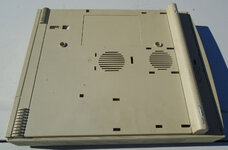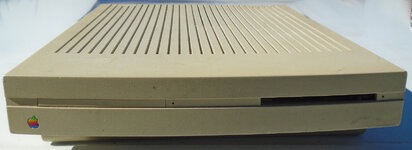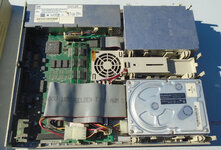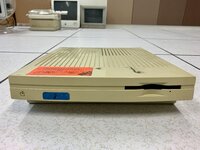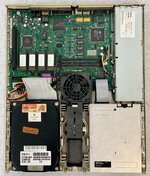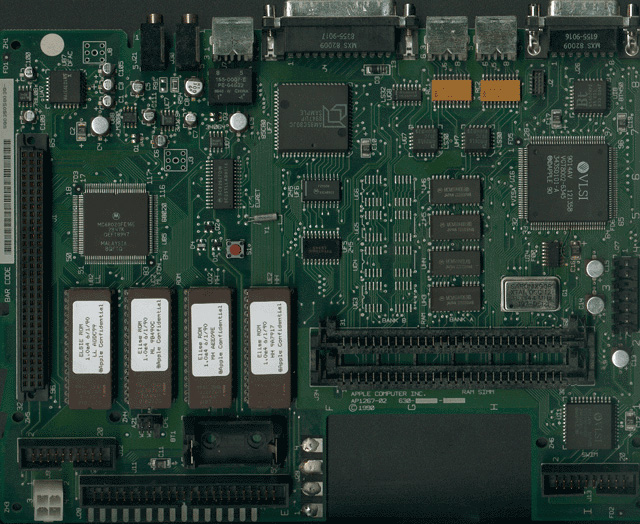Ok I'll bite, this is an interesting mystery and I have a hypothesis. Requires going through the What, Why, When, and Who.
The What: Prototype Parts
@ArmorAlley Fu Yu Manufacturing is a plastic molding company that worked with Apple (
Singapore Business, 1997)
@Performa450 Agree I think the bottom case is an Apple prototype given the identical details like internal ribs & structure to the shipped LC bottomcase. Seems like in Aug 1990 they were considering whether to have retractible feet or not. Makes sense this would be an open design question, as the monitor designed to sit atop the LC is not adjustable, whereas all other CRT monitors of the era were adjustable for optimal ergonomics. I think the spirit of low cost manufacturing that defined the LC won out (see the feature on the LC in
Macworld Nov 1990, pg170), and they choose to just build the permanent leg bump into it despite it's somewhat awkward style:
The Macintosh LC is designed for automated construction. The overall construction is very simple and consists of five basic pieces in addition to the box and the lid: the logic board, the power supply, a component containing both the fan and the speaker, a floppy disk and a hard disk. All the components fit in a flat layer, with no stacking. Direct connections are used wherever possible, and alignment holes are built into the logic board to guide robot arms for insertion of power and disk drive cables.
@3lectr1cPPC yes and the keyboard says 'For Engineering Evaluation' which means its not even a production Powerbook keyboard. It could be a Powerbook 100, 140, or 170 keyboard though. This is important!
Note the the top case is clearly a different mold process than the bottom case, using a flat back instead of the structural ribs of the LC bottom case. This suggests a very early in-house prototype, or an entirely different manufacturer of the top vs the bottom (despite their snow white stylistic similarity).
The When: Shortly before/during/after LC Release
Lets look at some relevant points in the timeline:
Nov 86 - Dynamac makes a portable Macintosh
??? 87 - Colby makes a portable Macintosh
Aug 89 - Outbound makes a portable Macintosh laptop for $3000-4000
Sept 89 - Macintosh Portable comes out for $4800-5500, looks like Dynamac and is significantly larger than the Outbound
Late 89 - Apple approaches Sony to work on Powerbook 100
Mar 90 - Apple IDG begins work on Powerbook 140 & 170 (
wikipedia)
Aug 90 - LC bottomcase with retractible feet manufactured
Oct 90 - LC is announced
Jan 91 - LC arrives at dealers
Jan 91 - Macworld Expo 91, which includes these facts:
Jan 91 - Apple delays updated version of Mac Portable, originally scheduled to release at Expo (
Tidbits: Filling the Portable Gap, 1991)
Jan 91 - Rumors are Apple is making smaller portable with Sony (
Tidbits: Filling the Portable Gap, 1991)
Jan 91 - Outbound and Dynamac trying to fill the demand for portable macs with new models (
Tidbits: Filling the Portable Gap, 1991), one of which sports a keyboard that looks like a Portable or Powerbook keyboard.
Feb 91 - Macintosh Portable refreshed with backlit display
Feb 91 - Apple IDG completes work on Powerbook 140 & 170 (
wikipedia)
Oct 91 - Powerbook 100, 140, 170 announcement
So we have the time between the topcase (Aug 90) and keyboard (pre-Oct 91). However, because the LC shipped to dealers in Jan 91 with the new style bottomcase, and this mystery model still has the August one, it may have been made up of parts from different dates. I think we can assume though that
this model was assembled sometime after August 90 and before Mar 91, when Powerbooks (and their keyboards) had reached design completion and were approaching PVT stage.
The Why: A Temporary Gap in the Market
An important question is why would someone go through all the trouble of making a jankier version of a Mac Portable? Consider what Apple is going through around Aug 90 - Jan 91:
- They've got a poor selling Macintosh Portable they're thinking about refreshing
- A few manufacturers have been making a small business selling niche portables based on the Mac
- Early Powerbooks are in the pipeline but won't be ready for a while
- The market demand for portables is growing as computing is growing at a fast pace (its the 90s!)
- They're making significant strides on low-cost manufacturing most notably with the upcoming LC
Basically
they need something to tide over the portable demand until the Powerbook is ready.
The Who: Either Dynamac or Apple
This gets to the final section, now that facts are assembled.
We know that Apple have a working relationship with Dynamac (
Infoworld, 1986):
Dynamac Computer Products Inc. and Apple Computer inked an agreement last week permitting Dynamac to buy discounted Macintosh Plus computers directly from Apple and reconfigure them into a portable package that includes a higher resolution display.
The company is the first maker of portable Macintosh machines to receive official support from Apple, which claims it has the legal right to limit the reconfiguration of its machine by others who intend to resell it.
And Outbound (
Tidbits: Filling the Portable Gap, 1991):
Other rumours in the same field focus on Apple’s joint efforts with Sony to develop a significantly smaller and lighter portable Mac, and on Apple’s purchase of technology developed by Outbound Systems and subsequent licensing of that same technology back to Outbound.
In general, Apple is using third parties to suss out early market demand that it can't/won't yet invest in. The history is there - Dynamac came out a year before the similarly shaped Portable, and Outbound came out with a laptop two years before Powerbooks. Third parties are at the vanguard of exploring Mac markets. Remember this is the era of Apple's openness, of the explosion of the Macintosh platform and all the third parties doing all the things, and of personal computing's rapid ascent.
These relationships suggest to me its possible that either Dynamac or Outbound could reasonably have access to early runs of the LC bottomcase and early powerbook keyboards.
The two obvious contenders for what this model is are thus a) a
Cheaper Macintosh Portable or b) the
Dynamac LC Display.
Cheaper Macintosh Portable
Apple could have looked at the LC case and the lower cost manufacturing approach of the LC and considered turning that into a cheaper version 2 of the Macintosh Portable. The expense of the Macintosh Portable was likely getting in the way of broader adoption, and third party macs were nipping at their heels with cheaper products. By August 1990 the Portable had only been on the market 11 months, and was not selling well. It was large, slow, expensive, and had a shit screen. The question may have been: could they take their work on the faster, cheaper LC and, with a small investment, make a better Macintosh Portable v2? Or refresh the existing Portable with a backlit screen? Cancelling outright wasn't likely an option, there were already sunk costs for the tooling and they needed
some kind of portable.
If they went through this exploration, it probably took a few months to do the case manufacturing and to see how the product came together. And that exploration could have caused the following delay:
From
Tidbits: Filling the Portable Gap, Jan 14 1991:
Apple recently announced a delay in the hoped-for updated version of its Macintosh Portable computer system, originally scheduled for release at this Macworld Expo. Rumours had suggested that the new computer would include a lighter battery assembly and a backlit liquid crystal display, taking care of two of the most pervasive complaints about the original Portable.
and
Tidbits Macworld Expo Briefs, Jan 14 1991:
One product that didn’t make it under the wire is Apple’s revised Macintosh Portable. The improved machine is rumoured to offer a backlit LCD screen, and a lighter battery assembly. The release has been postponed indefinitely; it’s not clear what effect that may have on the upcoming joint Apple-Sony project.
Dynamac LC Display
The other option is that Apple just absolutely
did not want to be in the luggable form factor business by Aug 90. It was just not a good form factor for people - they sat on desks more than they were lugged around, and they couldn't fit in a briefcase and thus were not in the important contexts where portable computing was desired. Apple even knew this when they launched the Portable in Sept 89, because they were already talking with Sony to miniaturize the Portable. Shortly after they spun up the Powerbook project and started throwing a lot of money at that. Powerbooks were the future, luggables were the past. The dismal sales of the Portable over the next 11 months only cemented that belief at Apple.
With this mindset, the LC-Portable was never a serious concept, and not worth building a whole new product for.
But Apple engineers and designers must have noticed the pizzabox form factor looked like it could have a portable bolted atop it. Maybe they even modeled the topcase design. And the business people knew they had a market gap problem, because by Aug 1990 it was still going to be at least another year before the Powerbooks arrived. What could fill the gap? Enter Dynamac.
Apple could have called them up and floated to them 'hey we have this LC, do you want to try to make a portable out of it?' and supplied them some prototype LCs. At this time, the LC still had the retractible legs. Dynamac decides they can make two types of portables out of this: one that uses the LC motherboard but is in a more compact laptop form factor (the
Dynamac IIsf), and another cheaper one that amounts to a LC conversion kit to turn it into a portable by replacing the topcase (LC Display). So they work from August 90 to January 91 on these two models, and announce them at Macworld Expo in Jan 91. From
Infoworld, Jan 24 1991:
Dynamac Computer Products Inc. demonstrated two new lines of Macintosh-based portable computers and a laptop display.
Dynamac's LC Display, a $1,299 flat-panel display, attaches to the CPU of a Macintosh LC computer, turning an LC into a portable. The 9½-inch backlit monochrome display gives LC users 640-by-480-pixel resolution with 16 shades of gray.
A portable computer configured using Dynamac's LC display weighs 13¼ pounds including the LC CPU and external keyboard. A battery that yields up to three hours of computer use adds 2½ pounds to the machine's weight. The LC Display is expected to ship in mid-March, said a Dynamac representative.

While this article shows a picture of a Dynamac IIsf (above), it doesn't show the LC Display. It also mentions an external keyboard is required. It's likely when they announced this at Macworld Expo, it was still in pretty early development and was announced to gauge demand. And there were three issues facing this product.
First, the retractible bottom leg of the LC was gone, replaced late in the cycle with a cheaper fixed leg by Apple. That fixed leg stuck out like a sore thumb for anything trying to resemble a portable.
Second, this still requires lugging along a big keyboard, and Dynamac probably got some feedback at the expo about how impractical that was. The IIsf (
seen pictured in this article) appears to have the same white Powerbook keyboard, probably given to them by Apple from recently completed engineering samples of the new Powerbook keyboards. So after receiving this feedback, they grab one of those keyboards and hack a hole in the topcase to see how that might be. The keyboard in this model isn't US English, which maybe means it was an 'extra' during Apple engineering prototyping, given to Dynamac once Apple didn't need it anymore.
Note that they may never have gotten to the stage of even wiring it up, as we don't see that in the pictures. This suggests it was exploratory form factor prototype, rather than a product going to market.
Third, they wanted to include a 640x480 LCD to maximize use of the LC's additional VRAM, but those may not have been widely/cheaply available. They tested the design with a Macintosh Portable's 640x400 LCD instead. Maybe Apple told them after they settled the design in Feb 91 that the Powerbooks were settling on 640x400 resolution.
By this point, the product is looking like a frankenstein, Apple's Powerbook is design complete and shaping up nicely, and Dynamac is making the assessment that this LC Display product is probably doomed. Note there is no evidence that the Dynamic LC Display was ever launched: it probably died shortly after the Macworld Expo due to feedback and the unworkability of the concept.
Finally, the providence of the model is from a magazine. Seems likely this was one of the many Mac trade publications like Tidbids, Macworld, Infoworld, etc. Maybe it was sent to the magazine to get reviewer feedback, which came back 'this thing is unworkable, why are you launching it' and the response was 'you're right, we've decided to cancel it. Don't worry about shipping it back you can just have it'.
---
Conclusion: I think its a post-Macworld Expo prototype of the
Dynamac LC Portable made shortly before it was cancelled, probably in Feb-Mar 91.


